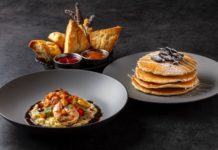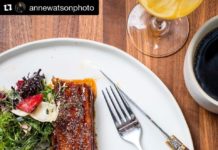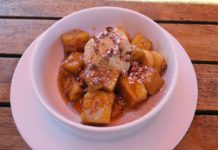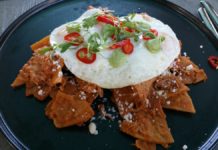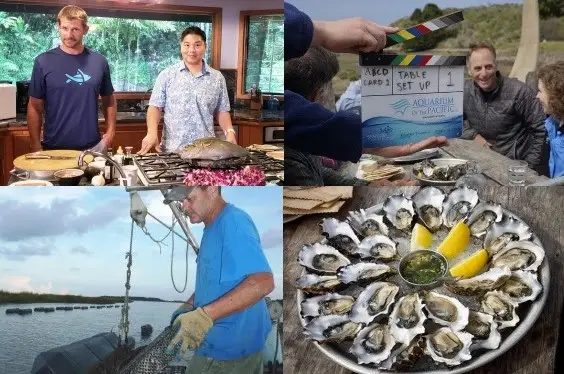The nonprofit Aquarium of the Pacific’s Seafood for the Future program, NOAA’s University of Southern California (USC) Sea Grant, and partners have released a new video series on sustainable seafood calledOcean to Table: Stories of Food, Farming, and Conservation. The Aquarium-led production features seafood farmers, scientists, and chefs from around the country sharing their efforts in producing and serving sustainable seafood. Each video showcases a different ocean farm with locally renowned chefs that host lively conversations with the farmer and aquaculture scientists over seafood from the featured farms. Cooking tips and recipes are also shared so anyone can enjoy fresh sustainable seafood at home with confidence. This launch includes the debut of five video programs and an interactive app available starting today. “We need to have sustainable food options for two billion more people as the global population grows over the next thirty years. Responsible ocean farming provides a promising opportunity to supplement well-managed wild fisheries to provide a healthy source of food with fewer environmental impacts relative to other animal proteins,” said Kimberly Thompson, Aquarium of the Pacific Seafood for the Future program manager.
The series aims to increase the public’s knowledge about the many types of aquaculture production, introduce the public to U.S. seafood farmers, show how science is applied on the farms to support best practices, and familiarize audiences with how to cook sustainable seafood dishes. “Farmed seafood is an essential part of healthy diets and a healthy planet. Participating in the resilience of our communities and ecosystems is as easy as cooking delicious seafood at home,” said Barton Seaver, chef and author ofAmerican Seafood: Heritage, Culture & Cookery from Sea to Shining Sea.
The Ocean to Table: Stories of Food, Farming, and Conservation series features farmers from Blue Ocean Mariculture (Hawaii); Hog Island Oyster Company (California); Lady’s Island Oysters (South Carolina); Ocean Approved Seaweed (Maine); and Wild Ocean Aquaculture, LLC (Maine). Scientists and experts from the National Oceanic and Atmospheric Administration (NOAA), South Carolina Sea Grant, The Nature Conservancy, Maine Aquaculture Association, University of California, Santa Barbara, and University of California, Santa Cruz, are also featured. Chefs appearing in the videos include chef and author Barton Seaver (Maine); James Beard Award-winner Stuart Brioza of State Bird Provisions & The Progress (California); Colin Hazama of Royal Hawaiian (Hawaii); and John Marshall of Old Bull Tavern (South Carolina). Seaver also narrates the series.
This series will be accompanied by an educational app-based interactive platform that will educate students and the public about marine aquaculture and its role in a sustainable food supply. It will be featured in the Seafood for the Future exhibit at the Aquarium of the Pacific starting October 2018 with the potential to reach more than 1.7 million visitors per year. NOAA’s USC Sea Grant will lead the development of educational materials (to be released in 2019), including teacher resource guides targeted for formal classroom and informal educators. The app platform, videos, and educational materials will also be available online. “New educational materials will help students explore the scientific, cultural, and social context of sustainable seafood,” said Linda Chilton, education programs manager at NOAA’s USC Sea Grant. “By reaching students, we are building community awareness of healthy nutrition, sustainable aquaculture, and fisheries careers.”
The collaborative project includes partnerships with NOAA’s USC Sea Grant, California Sea Grant, NOAA Fisheries Office of Aquaculture, NOAA National Ocean Service, California Department of Fish and Wildlife, and the Seafood Nutrition Partnership. This project was funded as part of $9.3 million in grants awarded by Sea Grant to support thirty-two projects in aquaculture research, outreach, and technical assistance. The initiative aims to advance aquaculture research, address barriers to aquaculture, and expand aquaculture production.
Visit SeafoodfortheFuture.org for the series, series extras (including profiles for the farmers, scientists, and chefs, and additional recipes), and more information about responsible ocean farming.
More than half of the global seafood supply comes from farmed sources. The U.S. is the world’s largest seafood importer. About 90 percent of our seafood is imported, most of which is farmed and has a higher likelihood of coming from poorly regulated and unsustainable farmed sources. The U.S. has great potential to expand marine aquaculture responsibly, in large part because it has the second largest exclusive economic zone in the world. According to a recent study, the U.S. could produce an amount of seafood equivalent to the total amount of seafood harvested from global wild fisheries in an area the size of Lake Michigan. “The U.S. has the scientific knowledge and technological capacity to expand responsible marine aquaculture to support healthy ecosystems, people, and economies and set the bar for other countries,” Thompson said.
The Aquarium of the Pacific and its Seafood for the Future program have a strong history of bringing together experts from diverse backgrounds to develop education and outreach resources on ocean science and conservation topics. The Aquarium has played a leading role in educating the public about responsible seafood, with an emphasis on the need for responsible marine aquaculture. Its efforts include the development of exhibits, programs, and videos, some of which have received national and international recognition.

